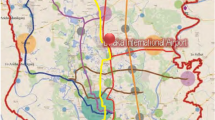Abstract
Increasing the ridership of bus transit through bus routing adjustment is one of the main tasks of transit agencies. A new method to characterize and classify bus routes according to their coverage, transfer and overlap level in meeting the needs of public transit planning is described. Geographic transit network and land use data are used to calculate seven indicators for each bus route: residential area coverage, non-residential area coverage, land use mix, transfer index to/from bus, overlap index with bus, transfer index to/from metro and overlap index with metro. Hierarchical clustering analysis is used to indicate where the largest potential scope exists for adjusting the bus transit system and hence can be used to guide transit planners. The method was applied in Nanjing, China aiming to identify improvable bus routes. Six bus route clusters were generated using hierarchical clustering. The profiles of each cluster are analysed and corresponding strategies for bus routing adjustment are proposed. ANOVA test shows there is a significant difference at the route-level ridership among these clusters, which verifies the reasonability of the method.
Foundation item: National Natural Science Foundation of China (51608483); Foundation of Zhejiang Educational Committee (G152104155800).
Access this chapter
Tax calculation will be finalised at checkout
Purchases are for personal use only
Similar content being viewed by others
References
Bus routing and coverage (2004) Transportation Research Board
Asadi Bagloee S, Ceder AA (2011) Transit-network design methodology for actual-size road networks. Transp Res Part B: Methodol 45(10):1787–1804
Currie G (2004) Gap analysis of public transport needs: measuring spatial distribution of public transport needs and identifying gaps in the quality of public transport provision. Transp Res Rec: J Transp Res Board 1895:137–146
Currie G (2010) Quantifying spatial gaps in public transport supply based on social needs. J Transp Geogr 18(1):31–41
Polzin SE, Pendyala RM, Navari S (2002) Development of time-of-day-based transit accessibility analysis tool. Transp Res Rec: J Transp Res Board 1799:35–41
Al Mamun S, Lownes NE (2011) Measuring service gaps: accessibility-based transit need index. Transp Res Rec: J Transp Res Board 2217:153–161
Minocha I, Sriraj PS, Metaxatos P et al (2008) Analysis of transit quality of service and employment accessibility for the greater Chicago, Illinois, region. Transp Res Rec: J Transp Res Board 2042:20–29
Making effective fixed-guideway transit investments: indicators of success (2014) Transportation Research Board
Elements needed to create high ridership transit systems (2005) Transportation Research Board
Weber county to salt lake city commuter rail project (2005) Utah Transit Authority
The transit competitive index web tool: development and applications. Cambridge Systematics and Transportation Analytics
Jiménez F, Román A, López JM (2013) Methodology for kinematic cycle characterization of vehicles with fixed routes in urban areas. Transp Res Part D: Transp Environ 22:14–22
Jiménez F, Serradilla F, Román A et al (2014) Bus line classification using neural networks. Transp Res Part D: Transp Environ 30:32–37
André M, Villanova A (2004) Characterisation of an urban bus network for environmental purposes. Sci Total Environ 334:85–99
Zhang H, Chen X, Li X (2011) Trip rate and travel time: a perspective in china city. Transportation Research Board 90th Annual Meeting. Washington, D.C.
Bus coverage of chinese cities [EB/OL]. http://www.beijingcitylab.com/ranking/, 6/20/2016
Walkscore [EB/OL]. http://www.walkscore.com/, 6/20/2016
Hastie T, Tibshirani R, Friedman J et al (2009) The elements of statistical learning, 2nd edn. Springer, Berlin
China City Statistical Yearbook (2016) China city statistical yearbook. China Statistics Press, Beijing, China
Author information
Authors and Affiliations
Corresponding author
Editor information
Editors and Affiliations
Rights and permissions
Copyright information
© 2019 Springer Nature Singapore Pte Ltd.
About this paper
Cite this paper
Deng, Yl. (2019). An Indicator-Based Method for Bus Routing Adjustment. In: Wang, W., Bengler, K., Jiang, X. (eds) Green Intelligent Transportation Systems. GITSS 2017. Lecture Notes in Electrical Engineering, vol 503. Springer, Singapore. https://doi.org/10.1007/978-981-13-0302-9_68
Download citation
DOI: https://doi.org/10.1007/978-981-13-0302-9_68
Published:
Publisher Name: Springer, Singapore
Print ISBN: 978-981-13-0301-2
Online ISBN: 978-981-13-0302-9
eBook Packages: EngineeringEngineering (R0)




